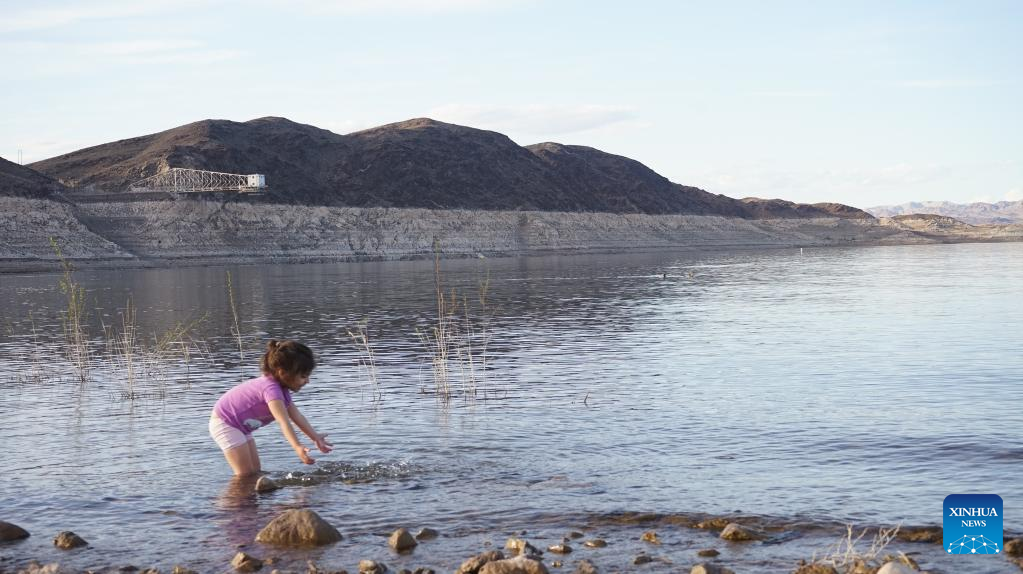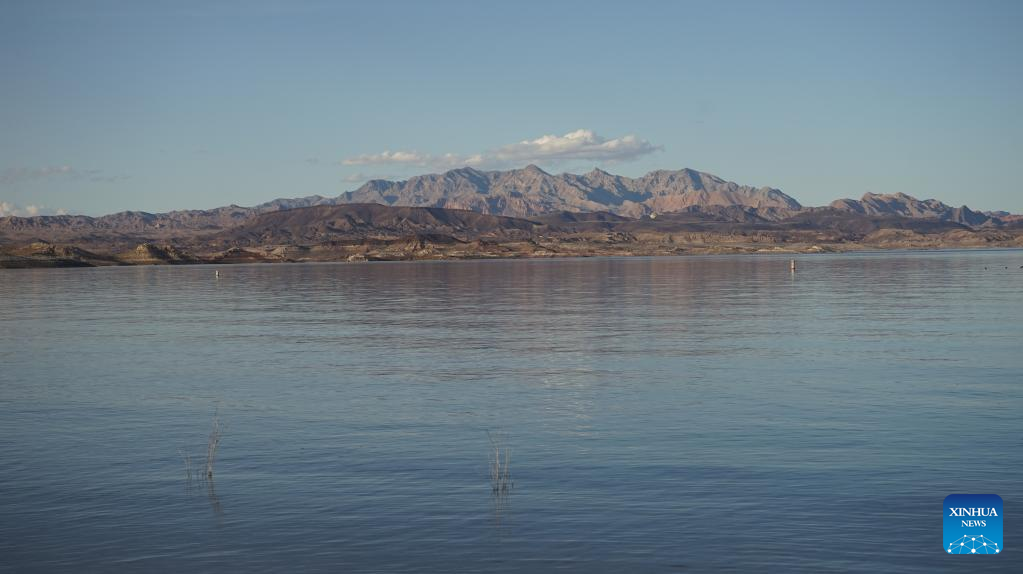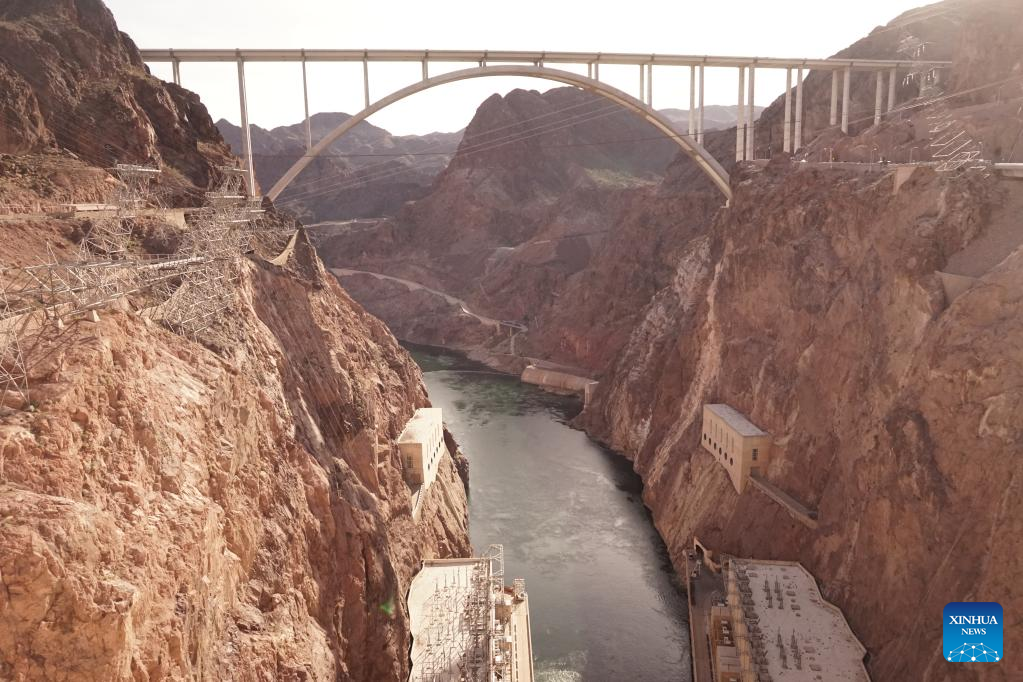
A girl plays with water in the shallows of Lake Mead on the side of Nevada, the United States, on March 13, 2023. The Colorado River, the parched lifeline in U.S. southwest, which supplies water to some 40 million people in seven states, got a jolt in the arm from the 2022-23 winter thanks to the snowpack that is melting and swelling streams and rivers. (Photo by Zeng Hui/Xinhua)
by Peter Mertz
DENVER, the United States, March 14 (Xinhua) -- The Colorado River, the parched lifeline in U.S. southwest, which supplies water to some 40 million people in seven states, got a jolt in the arm from the 2022-23 winter thanks to the snowpack that is melting and swelling streams and rivers.
The latest projection issued this January from the U.S. Bureau of Reclamation, which manages the Colorado River basin, was that Lake Mead, the biggest reservoir in the country, could drop close to the lowest level since it was initially filled in the 1930s.
With an above-average snowpack in the states of Colorado and Utah right now, hopes are that a slow spring melt could help reduce that projection. Lake Mead's water levels have been rising overall since the end of July. As of Tuesday it was at 1,045.96 feet above sea level, 5.35 feet higher than last year's record low level.
However, the unexpected relief from a historic 1,200-year drought that has gripped the region has a downside - flooding.
California is getting a double-whammy, record snowfall in the mountains coupled with recent monsoonal fronts invading from the Pacific Ocean.
This combination triggered "flash flooding emergency" warnings and sporadic flooding across the Golden State over the weekend, the Federal Emergency Management Agency (FEMA) said on its official website Monday, and it urged residents in parts of central California and western Nevada to pay attention to local officials as additional heavy rains and flooding were predicted.
Across the U.S. west, winter 2022-23 snowpacks ranged from 150 percent of normal in southern New Mexico's Gila River basin to 117 percent of normal in Montana's Madison River drainage, according to the Hatch Magazine, a popular online magazine and website providing information to fans of fly fishing.
However, the winter's heavy snows "won't put a noticeable dent in the ongoing western megadrought that started in 2000 and has persisted largely unabated since," the National Public Radio (NPR) reported.
"Everybody is so eager to make an early call on this," Brad Udall, a water and climate researcher at the Colorado State University, told NPR recently. "Invariably, you'll get caught with your pants down if you think you know what's going to happen."
As spring temperatures increase, local governments are warning residents to watch out for rising waters.
In Arizona, a flood warning will be in effect until Tuesday and covers the Salt River between Granite Reef Dam and Tempe Town Lake, according to AZCentral.com.
"Warming Arizona weather increases flood risks in parts of state," the Grand Canyon State media source said.
In Colorado, the mountain snowpack is beating the 30-year norm as spring nears, except for Arkansas River Basin where less snowfall could lead to low water flows, The Denver Post reported Friday.
In some drainages in Colorado, the snowpack to date is 150 percent of normal, according to the National Resources Conservation Service (NRCS).
NRCS said that the measurement gauge at Columbine Pass had recorded 250 percent of the median peak as of Feb. 11 and that the upper Colorado's cumulative snowpack sat at 125 percent of normal for the same date.
In Utah, NRCS listed the statewide snow water equivalent figure at 20.8 inches (52.8 centimeters) of water last week, gaining a little more than four inches over the past two weeks.
"The current snowpack is the highest it has been at any point since the 2016-2017 snow collection season peaked at 21.1 inches (53.6 centimeters) on March 9, 2017," KSL-TV based in Salt Lake City noted.
"Given the long-range outlook, this year has the potential to be one of the state's wettest since the records were first kept (in 1980)," KSL-TV added. The Utah record high was 26 inches (66.1 centimeters), set on April 13, 1983.
Last week, Utah Governor Spencer Cox took notice, tweeting that the current snowpack was actually higher than it was in early March 1983, as well as some of the other notable snowpack years since 1980.
In California, "the immense amounts of rain and snow California is experiencing this winter could morph into devastating floods under certain conditions," CalMatters.com reported last week, adding that "the winter of 2022-23 will go into the meteorological record books for one of the heaviest - if not, the heaviest - precipitation ever experienced in California."
Into March, California's snowpack "is approaching 200 percent its average for this point of the season," and rivalling 1982-83, which is the largest snowpack on record, according to the state's Department of Water Resources.
The record would likely be broken because meteorologists were forecasting storms for weeks to come, CalMatters said, warning that "there's a potential downside: major flooding if warm tropical storms drop huge amounts of water and suddenly melt the snowpack."
"Such juxtapositions of meteorological conditions can overwhelm the carrying capacity of the rivers and the dams that are supposed to control river flows," the report added.
Native American tribes, who rely on water to irrigate crops, were optimistic the upped water supply would help their livelihoods.
"Colorado's Western Slope has had above average snowpack for all of 2023, which has been great," The Southern Ute Drum (SUD), a biweekly community newspaper run by the Southern Ute Indian Tribe, reported Friday.
"Southwest Colorado river basins currently have 142 percent of Normal Snow Water Equivalent (SWE) which should provide a great runoff season to fill most reservoirs and provide a good irrigation season."
SUD is the primary media source for some 13,000 Utes living near the large four-state region of Colorado, Arizona, New Mexico and Utah, and thousands of other Native Americans who rely on water from the Colorado basin to grow the crops they need for their survival. ■

Photo taken on March 13, 2023 shows Lake Mead on the side of Nevada, the United States. The Colorado River, the parched lifeline in U.S. southwest, which supplies water to some 40 million people in seven states, got a jolt in the arm from the 2022-23 winter thanks to the snowpack that is melting and swelling streams and rivers. (Photo by Zeng Hui/Xinhua)

(230314) -- HOOVER DAM (U.S.), March 14, 2023 (Xinhua) -- Photo taken on March 13, 2023 shows the Colorado River near Hoover Dam on the Arizona-Nevada border, the United States. The Colorado River, the parched lifeline in U.S. southwest, which supplies water to some 40 million people in seven states, got a jolt in the arm from the 2022-23 winter thanks to the snowpack that is melting and swelling streams and rivers. (Photo by Zeng Hui/Xinhua)

(230314) -- HOOVER DAM (U.S.), March 14, 2023 (Xinhua) -- Photo taken on March 13, 2023 shows the Colorado River near Hoover Dam on the Arizona-Nevada border, the United States. The Colorado River, the parched lifeline in U.S. southwest, which supplies water to some 40 million people in seven states, got a jolt in the arm from the 2022-23 winter thanks to the snowpack that is melting and swelling streams and rivers. (Photo by Zeng Hui/Xinhua)
